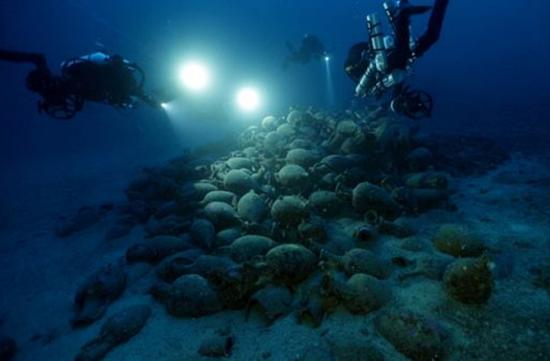Rossella Lorenzi
Source - http://news.discovery.com/history/archaeology/ancient-mediterranean-sailors-made-sacrifices-on-ships-141014.htm#mkcpgn=rssnws1

In the area of the wreck's bow, the archaeologists found many large terracotta jars, known as amphora, piled on the sea floor. SEA SUPERINTENDENCY, SICILY
Ancient Mediterranean sailors performed religious ceremonies and sacrifices on board their ships, according to new findings from a 2,000-year-old shipwreck.
Using a deep sea mini-submarine, archaeologists of the Sicilian Sea Superintendency and Global Underwater Explorers (GUE) divers found the wreck and its cargo of jars at a depth of 420 feet in the waters of Sicily's Aeolian islands.
In the area of the bow -- a portion of the wooden hull is still preserved -- the archaeologists found a terracotta incense burner called thymiaterion. Consisting of a large bowl supported by a column, the thymiaterion had a base embellished with stylized sea waves. A Greek inscription of three letters (ETH) was also found on the base.
"The object confirms historical accounts of sacrifices and rituals performed at sea to protect the voyages," Sebastiano Tusa, Sicily's Superintendent of the Sea Office, told Discovery News.
Tusa and the GUE divers also found many large terracotta jars, called amphora, piled on the sea floor. These jars were used as shipping containers and carried trade products such as honey, olive oil, wine and fish sauce.
Among the jars, divers found bowls and cylindrical vases. But the incense burner remains the most important find.

"There are only a handful of other incense burners that have come from wrecks throughout the entire Mediterranean," Aaron Brody, associate professor of bible and archaeology and director of the Bade Museum at Pacific School of Religion, Berkeley, Calif., told Discovery News.
An expert in maritime religion, Brody explained that religious rites were performed while a ship left port and when it entered a harbor safely.
But rituals were also officiated in between, during the navigation, passing landmarks, or in times of distress.
"Their purpose was to either appease or thank gods who controlled the winds or who could aid in proper navigation, or when auspicious natural features were within sight, like mountain peaks or landmarks dedicated to deities," Brody said.
Typically, the rituals took place at sacred locations aboard ships, often in the prow and or the stern, and involved animal sacrifices, prayer, offering, libation, or vow.
"The presence of the incense burner aboard the vessel suggests rites that were easy to fulfill at any time since incense is light and portable," Brody said.
However, the incense burner and the rituals linked to it, didn't work particularly well. The ship sunk, possibly capsizing on its left side.
"The position of the cargo on the seafloor indicates that jars and object originally stored in the bow area were overturned and thrown out the vessel," Tusa said.